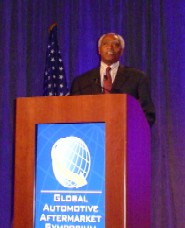Winning the Consumer Products Battle: How Today’s Small and Large Companies are Succeeding Through Innovation, with Sandy Brawley, President, GameChanger Products
 In the 1970s, most innovation was coming from big companies, says Sandy Brawly, president, GameChanger products. But by the 1980s, small companies began to exceed large companies.
In the 1970s, most innovation was coming from big companies, says Sandy Brawly, president, GameChanger products. But by the 1980s, small companies began to exceed large companies.
That continued and now, “it’s not even close today,” he said.
He cited the example of Coca-Cola, which recently unveiled a pop machine that lets consumers mix their own drinks. It’s not just a novelty. Each time a consumer makes a new concoction, that information is recorded and sent back to the company, he said. The data is assisting the company to design new products that meet consumer likes.
Brawly introduced what he called the new five Ps of marketing:
*Purpose. A product has to have purpose beyond what it’s designed to do.
*Passion. A company that has a passion for its products will shine over those that just want to sell more.
*Personality. Brawly cited Ben & Jerry’s ice cream. The founders’ personalities drove the brand. Pop-culture defined flavors; premium pints; lifestyle and social cause marketing all added to the company’s personality. The company just opened a store that high school kids are going to run and all the proceeds will go to the Salvation Army.
*Precision. Brawley gave the example of Master Replicas. The company produces high-end replicas of Star Wars movie toys. They built a $50 million business in five years, Brawly said. Their average customer spends $500 a year with them.
*Pace. It’s about getting products to the consumer with or without retailers.
Brawley also introduced the new seven deadly sins in business:
*Business blindness. Participating in a product category often makes it more difficult to see the disruptive trends and opportunities in that category. For example, Folgers coffee and Starbucks. Starbucks approached coffee in a whole different way.
*Self-reliance syndrome. It’s the, “I believe as a manufacturer that I have to build it. That I can build it better than anybody else. Entrepreneurs don’t think that way. They think where can I get this built to the specifications?”
*Bureaucratic burial. Brawley counseled a company that had to get 21 signoffs before they could take a product through testing. “Can you imagine how long that takes when you’re competing against an entrepreneur who will make that decision this afternoon?” Brawley asked.
*Specialist stagnation. A company needs to be able to move quickly through the product development process.
*Mindset mismatch. You hire people to run businesses very efficiently and these people may or may not be able to find innovation and make new things. There are people at very high levels who think about why things won’t work instead of thinking how do we move the roadblock to move forward. Entrepreneurs don’t think that way.
*The big bang launch – You invest money in an idea and all you can afford and hold hands and go to the edge and they jump together. “If it’s a bad idea, this jump’s a bad thing, right?” Brawley said. If a company plans to invest $1 million, don’t put it on one idea. Create 10 possibilities or choices. Not all of them are going to be successful. But you can afford to lose three or four of them if some of the ideas work.
*Portfolio pitfalls. Taking one idea and trying to make it work at any cost. Part of the efficiency in running a business the right way is knowing when to cut the cord. Most companies over-invest in individual new product ideas and fail to cut off bad ideas fast enough.
http://www.counterman.com/Article/73999/highlights_from_the_15th_annual_global_automo.aspx






